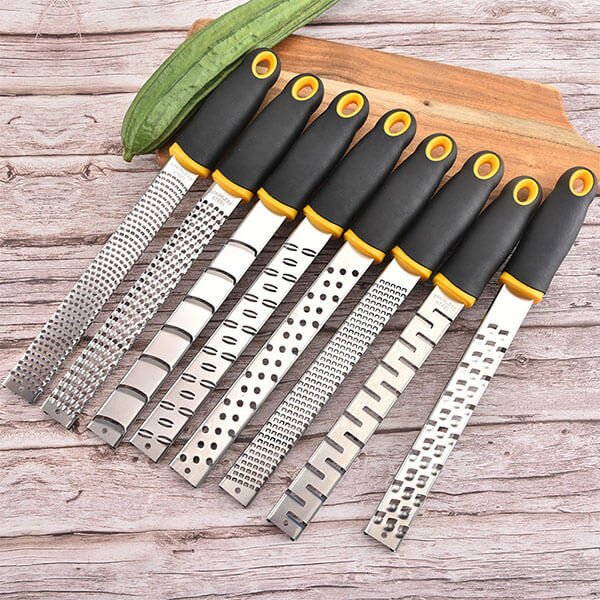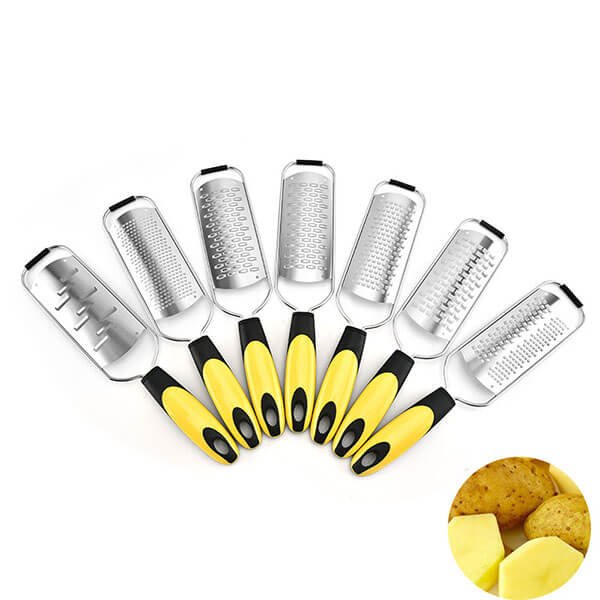What is the Difference Between a Zester and a Grater?
Culinary tools play a crucial role in the art of cooking, and understanding the nuances of each tool can elevate your culinary prowess. In the realm of kitchen gadgets, zesters and graters are two essential tools with distinct purposes. Whether you’re a seasoned chef or an enthusiastic home cook, knowing the difference between a zester and a grater can make a significant impact on the flavors and textures you create. In this comprehensive guide, we will delve into the world of zesters and graters, unraveling their unique characteristics, exploring their applications, and helping you choose the right tool for your culinary endeavors. By the end, you’ll have a solid understanding of these versatile kitchen essentials, empowering you to create delightful dishes with precision and finesse.

Understanding Zesters
A zester is a kitchen tool specifically designed to extract the zest, or outermost layer, of citrus fruits. The primary purpose of a zester is to capture the flavorful and aromatic oils found in the zest, enhancing the taste and aroma of dishes.
Common types of zesters
Classic zester: This type features a narrow, elongated design with small sharp holes or slits for zest extraction.
Microplane zester: The Microplane zester is a popular variation known for its ultra-fine blades that effortlessly produce fine zest without tearing the fruit’s pith.
Features and characteristics of zesters
Design and shape:
Narrow shape with a handle for easy gripping and maneuvering.
Ergonomic designs for comfortable use over extended periods.
Blade types and sizes:
Sharp, small holes or slits on the zester’s surface for optimal zest extraction.
Different blade sizes cater to various zest thickness preferences.
Ideal uses for zesters
Extracting zest from citrus fruits:
Lemon, lime, orange, and grapefruit are common fruits used for zest extraction.
Zest adds intense flavor and fragrance to dishes, desserts, cocktails, and sauces.
Creating fine shreds for garnishing:
Zesters are adept at producing delicate strands of zest to elevate the presentation of culinary creations.
Zest can be sprinkled on top of dishes or used as a decorative element.
Exploring Graters
A grater is a versatile kitchen tool designed to shred or grate various ingredients into smaller, uniform pieces. Graters are commonly used for cheese, vegetables, spices, and hard fruits, offering a convenient way to prepare ingredients for cooking or garnishing.
Various types of graters
Box grater: This type of grater features multiple sides with different grating surfaces, such as fine, medium, and coarse.
Rotary grater: A rotary grater utilizes a rotating drum with sharp blades that easily shred ingredients with a simple turning motion.
Flat grater: Flat graters have a single flat surface with sharp holes or blades, allowing for efficient grating in one direction.
Features and characteristics of graters
Number and size of grating surfaces:
- Box graters offer versatility with multiple grating options on different sides, catering to varying ingredient textures.
- Rotary graters often have a single grating drum with interchangeable blades for different levels of coarseness.
- Flat graters have a fixed grating surface, usually with varying hole sizes or blade configurations for specific tasks.
Materials and durability
- Graters are typically made of stainless steel, which is known for its durability, resistance to corrosion, and easy cleaning.
- Some graters may have additional features like non-slip bases or ergonomic handles for enhanced stability and user comfort.
Versatile uses for graters
Shredding cheese and vegetables
- Graters are excellent for quickly and uniformly grating cheese, saving time in meal preparation or garnishing.
- Vegetables like carrots, zucchini, or potatoes can be shredded using graters to create ingredients for salads, stir-fries, or fritters.
Grating spices and hard fruits
- Graters enable the effortless grating of spices such as nutmeg or ginger, unlocking their flavors for various recipes.
- Hard fruits like apples or pears can be grated to add texture and flavor to baked goods or salads.
Key Differences Between Zesters and Graters
Design and structure dissimilarities
Zester’s narrow shape vs. grater’s broader structure
- Zesters are typically long and narrow, allowing for precise control and ease of zesting.
- Graters, on the other hand, have a broader structure with larger grating surfaces, providing more coverage and capacity for grating ingredients.
Zester’s single fine blade vs. grater’s multiple grating surfaces
- Zesters usually have a single fine blade or small holes for extracting zest.
- Graters feature multiple grating surfaces, each with varying hole sizes or blades, providing options for different grating thicknesses.
Intended applications and results
Zester’s focus on extracting zest for flavor enhancement
- Zesters excel at precisely removing the outer layer of citrus fruits, capturing the fragrant oils found in the zest.
- The zest adds tanginess, brightness, and aroma to dishes, desserts, and beverages, enhancing their overall flavor profile.
Grater’s ability to shred or grate a variety of ingredients
- Graters are versatile tools suitable for shredding or grating a wide range of ingredients like cheese, vegetables, spices, or hard fruits
- The grating process produces uniformly grated or shredded pieces, ideal for even cooking, melting, or incorporating into recipes.
Variations in ease of use and maintenance
Zester’s simplicity and ease of cleaning:
- Zesters are generally straightforward to use, requiring a simple back-and-forth motion over the fruit’s surface.
- Cleaning a zester is typically uncomplicated, as the fine blade or holes can be rinsed or brushed easily to remove any residue.
Grater’s varying complexity and cleaning challenges:
- Depending on the grater type, using it may involve holding, rotating, or sliding the ingredient against the grating surface.
- Due to the multiple grating surfaces and potentially intricate designs, graters may require more attention when cleaning to remove trapped food particles.
Conclusion
Understanding the difference between a zester and a grater is essential for anyone seeking to enhance their culinary skills. While both tools share the purpose of processing ingredients, they possess distinct features and applications. Zesters, with their narrow shape and fine blades, excel at extracting zest from citrus fruits, adding vibrant flavors and aromas to various dishes. On the other hand, graters, with their broader structure and multiple grating surfaces, offer versatility in shredding or grating ingredients like cheese, vegetables, and spices, allowing for even cooking and seamless incorporation into recipes.
Interested in our products or need OEM services?
Please fill in your information in the form below, we will contact you as soon as possible



